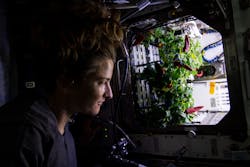NASA features horticulture in its ISS photos of the year
No sooner had we looked at the International Space Station’s latest horticultural lighting project than we spotted NASA’s freshly-posted list of its own favorite pictures from the ISS over the last year. And whadya know: Horticulture, and by inference horticultural lighting, featured prominently.
NASA singled out a chili pepper project and another in which astronauts cultivated bok choy among the 25 photos on its web post “Best Space Station Science Pictures of 2021.”
The space agency double dipped on the chilis, presenting two photos. In one of them, astronaut Kayla Barron floats, smiling, in front of the Advanced Plant Habitat (APH), where a luscious-looking batch of red chili peppers awaits harvesting. In the second photo, astronauts Mark Vande Hei, Shane Kimbrough, Akihiko Hoshide, and Megan McArthur show off another lot of both red and green chilies which they helped to grow, also in the APH.
The APH, as LEDs Magazine has chronicled, is one of the more sophisticated of the numerous horticultural lighting projects on the ISS, which orbits Earth every 90 minutes, or about 16 times a day. It offers a rich spectral content delivered by specially-tuned LEDs inside a closed chamber. We’ve reported on its use in growing radishes and in its role in studying lignin, a natural polymer that provides a plant with structure and rigidity.
NASA has grown a number of species inside the APH, including dwarf wheat as well as cabbage- and mustard-like plants in the Arabidopsis genus, which includes thale cress.
In another honored horticultural image (not shown), astronaut Michael Hopkins breathes in the aroma of a hearty-looking crop of extra dwarf bok choy (or pak choi, depending on your preferred spelling; in fact, you might also spell “chili” differently). Astronauts grew the vegetables in the Space Station’s LED-lit VEGGIE chamber, which is less spectrally rich than the APH. VEGGIE is open rather than closed, allowing crew members to freely reach in and snip.
Astronauts have grown various green goodies in VEGGIE, including mizuna mustard greens.
As we reported last week, NASA continues to study various aspects of growing food under the lights on the Space Station, which circles around 220 miles above Earth. The primary idea is to learn how to sustain people on future space flights and missions. The work could also offer insights for horticulture on Earth, where horticultural lighting in controlled environment agriculture (CEA) could play a big role in food security and in medicinal crops including cannabis.
In the days before Christmas, NASA sent up the latest horticultural experiment intended to look at seeds, roots, and shoots in Petri plates for the purpose of examining how regulatory RNA and molecular mechanisms sense and respond to the unfamiliar space environment.
The horticultural photos joined others related to studying muscle tissue, storm spotting, low temperature flames, and more, including photos of space vehicles delivering to the ISS, and of the solar panels that power the spacecraft. You can see them all on the NASA website.
MARK HALPER is a contributing editor for LEDs Magazine, and an energy, technology, and business journalist ([email protected]).
For up-to-the-minute LED and SSL updates, why not follow us on Twitter? You’ll find curated content and commentary, as well as information on industry events, webcasts, and surveys on our LinkedIn Company Page and our Facebook page.

Mark Halper | Contributing Editor, LEDs Magazine, and Business/Energy/Technology Journalist
Mark Halper is a freelance business, technology, and science journalist who covers everything from media moguls to subatomic particles. Halper has written from locations around the world for TIME Magazine, Fortune, Forbes, the New York Times, the Financial Times, the Guardian, CBS, Wired, and many others. A US citizen living in Britain, he cut his journalism teeth cutting and pasting copy for an English-language daily newspaper in Mexico City. Halper has a BA in history from Cornell University.






